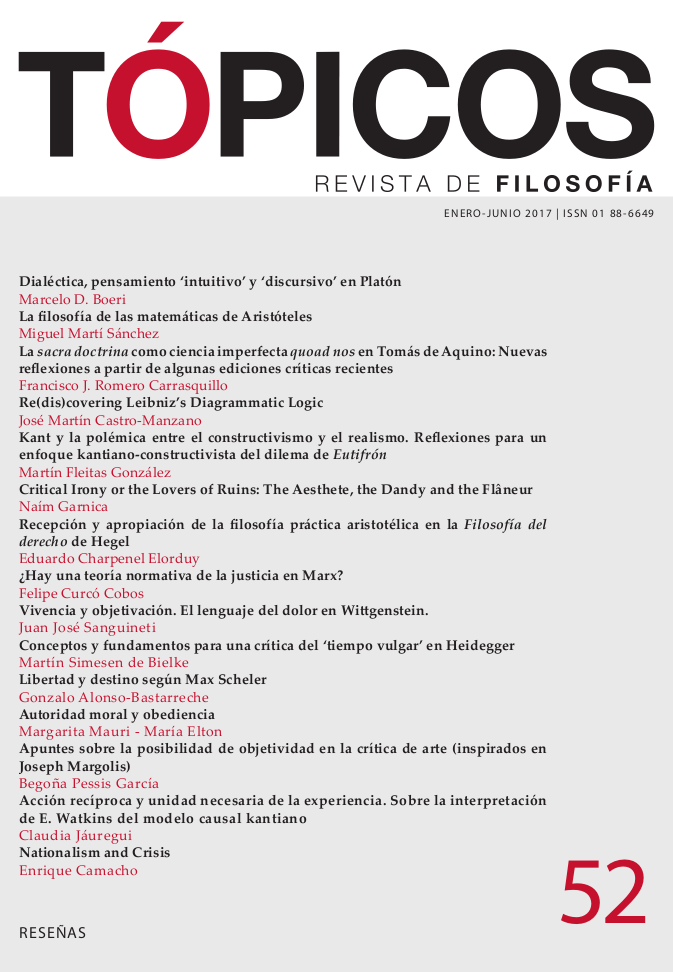Notes about the Possibility of Objectivity on Art Criticism (Inspired by the Work of Joseph Margolis)
Published 2016-12-27
How to Cite
Downloads
Altmetrics
Citas
Abstract
The question concerning the possibility of objectivity in critical judgments about art arises especially if we consider art- works as Intentional objects, radically different from the merely physical. With this question in mind, the following paper aims to argue that, specially in the context of analytic tradition of this problem, Margolis` doctrine seems to be the strongest bet, because it can deal with the challenges that peculiar character of artworks suggests. In addition, I will propose that the concept of historical intersubjectivity can face adequately the challenges and difficulties posed by artworks. Finally, I will enunciate the advantages of this term over “objectivity”.
References
- Carroll, N. (2009). On Criticism. New York, Oxon: Routledge.
- Davies, S. (1995). Relativism in Interpretation. En The Journal of Aesthetics and Art Criticism, Vol. 53, Núm. 1, 8-13.
- Garcia Leal, J. (2001). Pluralidad de interpretaciones en el arte. En Thémata. Núm. 27, 31-38.
- Ibarlucía, R. (2016). Descripción y evaluación. Algunas observaciones sobre el discurso de la crítica. En Pérez, D. e Ibarlucía, R. (comps.). Hechos y valores en filosofía teórica, filosofía práctica y filosofía del arte. (213-224). Buenos Aires: Centro de Investigaciones Filosóficas y Sociedad Argentina de Análisis Filosófico. [En prensa]
- Kant, I. (2015). Kritik der Urteilskraft. Wilhelm Weischedel (ed). Band X. Frankfurt am Main: Suhrkamp Verlag (stw).
- Margolis, J. (2009). The arts and the definition of the human: toward a philosophical anthropology. Stanford: Stanford University Press.
- ________ (2001). Selves and other texts: the case for cultural realism. University Park, PA: The Pennsylvania State University Press.
- ________ (2000). The Deviant Ontology of Artworks. En Carrol, Noël (ed). Theories of Art Today. (109-129). Wisconsin: The University of Winconsin Press.
- ________ (1999). What, after all, is a work of art? University Park, PA: The Pennsylvania State University Press.
- ________(1998). Objectivity as a Problem: An A empt at an Overview. En The Annals of the American Academy of Political and Social Science. Vol. 560, 55-68.
- ________ (1995a). Historied Thought, Constructed World: A Conceptual Primer for the Turn of the Millennium. Berkeley: University of California Press.
- ________(1995b). Interpretation Radical but Not Unruly: The New Puzzle of the Arts and History. Berkeley: University of California Press.
- ________ (1995c). Plain talk about interpretation on a relativistic model. En Journal of Aesthetics and Art Criticism. Vol. 53, Núm. 1, 1-7.
- Schaeffer, J. (2013). Pequeña ecología de los estudios literarios. Fólica, L. (trad.) Buenos Aires: Fondo de cultura económica.
- Stecker, R. (1996). Artworks: Meaning, Definition, Value. University Park, PA: The Pennsylvania State University Press.
- ________ (1992). Incompatible Interpretations. En The Journal of Aesthetics and Art Criticism. Vol. 50, Núm. 4, 291-298.






